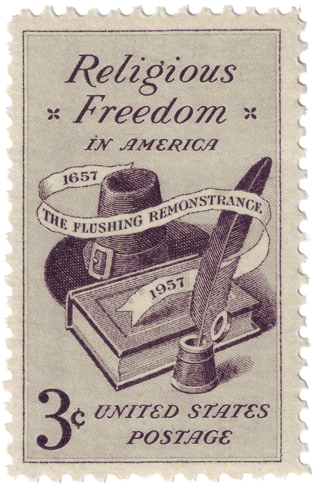Updating a post from 2006, I’d like to take a look back at the commemorative stamp issues of 1957. What do we choose to remember, and how do we remember it? What was considered significant back in 1957, but is now forgotten? What icons have remained with us, and which have faded from view?
First up is Scott #1086, the Alexander Hamilton bicentennial issue, in rose red from a design by the Bureau of Engraving and Printing’s William K. Schrage.
Hamilton, was born in the West Indies, on the island of Nevis, thus Constitutionally unable to be President, though well-qualified otherwise. He was a member of General Washington’s staff, later our first Treasury Secretary, co-author of the Federalist Papers. He was shot and killed by Vice President Aaron Burr in a duel.
The design also features the old Federal Hall in New York City, which was the original national capitol building, before the move to Washington, DC.
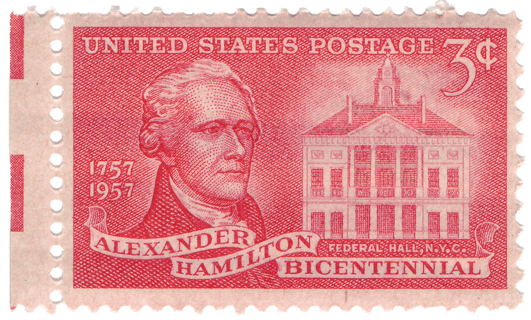
Scott # 1087, designed by Charles R. Chickering, commemorates the 20th anniversary of the National Foundation for Infantile Paralysis, later called the March of Dimes. The deisgn features a woman/nurse, a boy and girl (the youth of the nation most benefited from the historic medical achievement) and the caduceus emblem on the shield, the symbol of the medical profession.
Those of us born after polio was eradicated may not appreciate the massive effort, in education and vaccination, that occurred in the 1950’s to wipe out polio. One poll at the time indicated that more people knew about the polio vaccine than knew the name of the President. Almost 2 million participated in clinical trials of the Salk vaccination. By 1957 the number of polio cases were dramatically falling. It was time for a victory stamp. Note that it says “Honoring those who helped fight polio” not “Honoring those who are helping fight polio”. It was clear that the fight had been won.
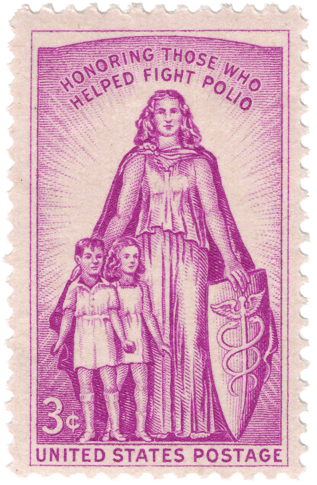
Scott #1088 commemorates the 150th anniversary of the Coast and Geodetic Survey. This orgaization was broken up in 1970 and split into the National Geodetic Survey and the Office of Coast Survey, both parts of NOAA.
Note the light bursts streaming out from the horizon. That seemed to be a popular effect in 1957, featured in the March of Dimes stamp above, as well as in Oklahoma statehood and Old Glory issues below.
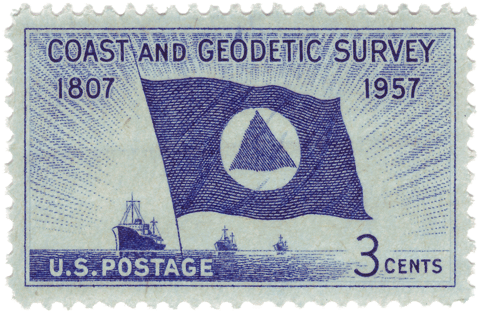
Scott #1089, design by Robert J. Schultz, honors the American Institute of Architects on their centennial. Originally formed as the “New York Society of Architects” with 13 members, the are still going strong with over 80,000 members. They have a nice web page with a retrospective, “Celebrating the Past, Designing the Future“.
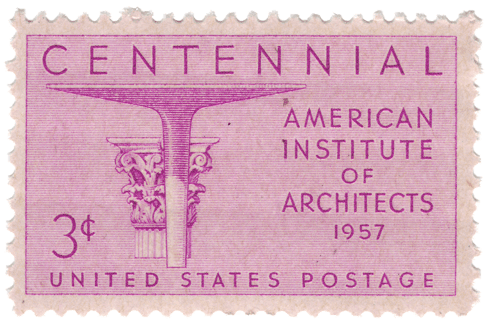
The next story does not have a happy ending. 1857 was the founding of the Saucona Iron Company, later called Bethlehem Steel. They were the top ship builder of WW II, with over 1,000 ships, employing over 300,000. They made the steel that built the Golden Gate Bridge and much of NYC’s skyline. They reached their peak in the 1950’s, one of the largest corporations in America and the highest-paid executive executive in the the country.
This stamp, Scott #1090, was issued at the height of Bethlehem Steel and the US steel industry. The bold, proud design was by Antonio Petruccelli, well-known for his Fortune Magazine covers and other illustrations.
So where is the celebration of the 150th anniversary of the American steel industry?
There isn’t one. The Bethlehem plant closed in 1995 and the company was bankrupt by 2001.
“Look on my works, ye mighty, and despair!”
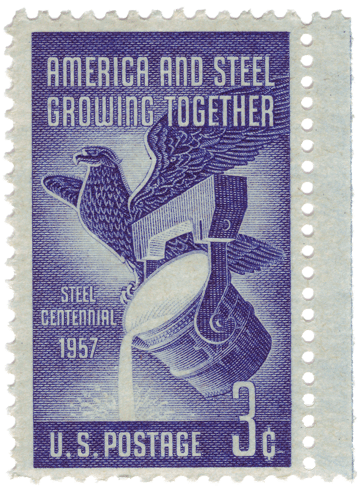
Next up is the 1957 International Naval Review commemorative, with design by Richard A.Genders. This was held in conjunction with the Jamestown 350th anniversary. In 2007 we certainly saw a lot of celebrations of observances of the 400th anniversary there.
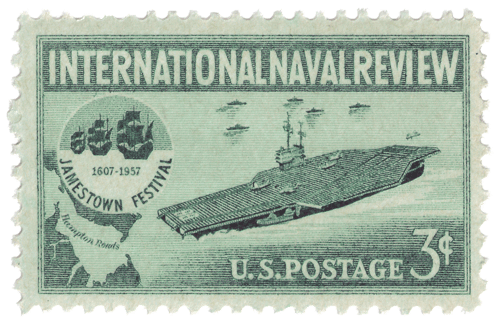
Now comes a puzzle. The next stamp marked the 50th anniversary of Oklahoma statehood, with an issue featuring the title “Arrows to Atoms”. The arrows part is clear enough — Oklahoma, formally called the Indian Territory, was home to many tribes, including the Cerokee, Chichasaw, Choctaw, Creek and Seminole.
But what was the connection to the atom? I have absolutely nothing on this. Anyone have any ideas? Is this just 1950’s atom-age kitsch? Or was there some significant Oklahoma connection to early atomic testing? (I didn’t see any talk of atoms in Oklahoma’s 100th anniversary celebrations this year.)
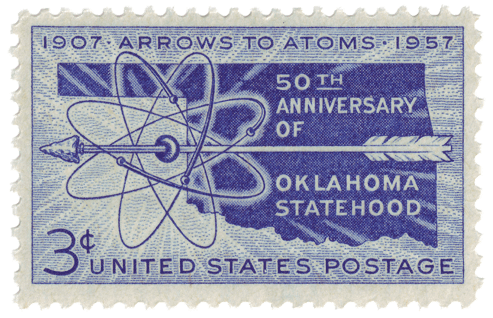
Next up is the National Education Association, the NEA, the largest labor union in the country, with a staff of 550 and a budget of $300 million. Founded in 1857 when the New York Teachers Association put out a nation-wide call for public school teachers to unite, it celebrated its centennial in 1957. Still going strong at age 150. Unlike steel workers, we’ll always need teachers.
If we did this stamp over again today, I wonder if we would show a laptop rather than a globe?
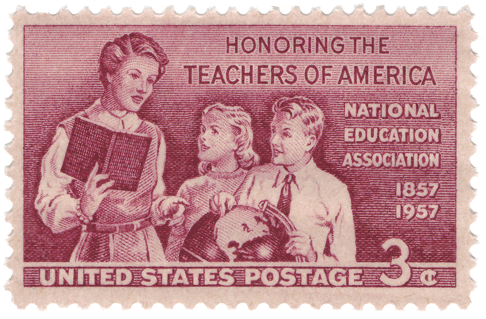
Here is my favorite stamp of 1957, the 48-star “Old Glory” issue, designed by Victor S. McCloseky, Jr. This is the first issue in the US to use the Giori press, a form of intaglio which used precisely cut ink rollers which could apply two or three ink colors to the same press, which then could be applied to the sheet in a single pass, avoiding the types of misalignment problems which could occur in multi-pass color processes.
Maybe I’m getting old and curmudgeonly, but you can keep your modern “stickers” that they pass off for postage stamps today. The Incredible Hulk? Muppets? Darth Vadar? When did we run out of real heroes to put on our stamps that we need to resort to fictional (and highly commercial) characters?
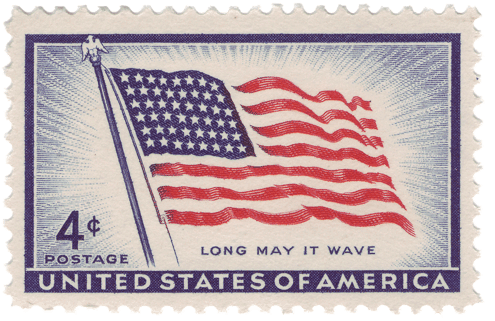
1957 saw the 350th anniversary of the first British ship built in the new world, the Virginia of Sagadahoc, built in the short-lived Popham Colony, in Maine. This is a small stamp, but lists 4 designers: Ervine Metzel, Mrs. William Zorach, A.M. Main, Jr. and George F. Cary II. That is somewhat unusual. There is nothing elaborate about this design that would suggest a need for 4 designers. I wonder if this was the result of a design contest, with citizen submissions plus actualization by B.E.P. professionals like Metzel?
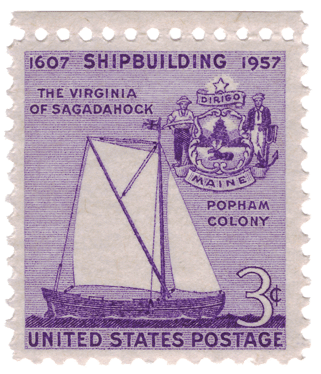
Another Ervine Metzel design, this on 200th anniversary of the birth Lafayette, the Frenchman who gave notable service in both the American and French Revolutions. His popularity in the U.S. was enormous in the 19th century and most U.S. states have towns or counties named Lafayette (or Fayette or Fayetteville), and many towns have a street named after him, often intersecting with, or near a Washington Street.

Another Giori press issue, raising awareness of wildlife conservation and the plight of the endangered Whooping Crane.
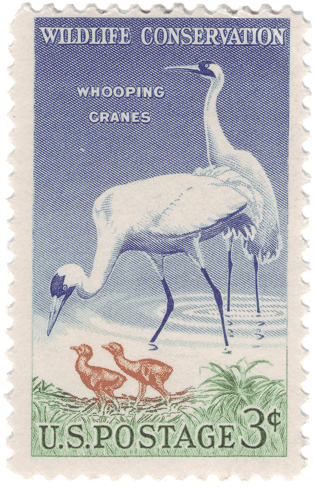
Finally, we have a commemoration of the Flushing Remonstrance. This, like the Diet of Worms or the the Synod of Hippo, sounds a lot funnier than it is. Not as well-known as it should be, the Flushing Remonstrance was a protest by English farmers under Dutch jurisdiction in New Netherlands (later New York) against the government sanctioned persecution of the Quakers. It is one of the earliest American statement on religious toleration:
The law of love, peace and liberty in the states extending to Jews, Turks, and Egyptians, as they are considered the sonnes of Adam, which is the glory of the outward state of Holland, soe love, peace and liberty, extending to all in Christ Jesus, condemns hatred, war and bondage. And because our Saviour saith it is impossible but that offenses will come, but woe unto him by whom they cometh, our desire is not to offend one of his little ones, in whatsoever form, name or title he appears in, whether Presbyterian, Independent, Baptist or Quaker, but shall be glad to see anything of God in any of them, desiring to doe unto all men as we desire all men should doe unto us, which is the true law both of Church and State; for our Savior saith this is the law and the prophets. Therefore, if any of these said persons come in love unto us, wee cannot in conscience lay violent hands upon them, but give them free egresse and regresse unto our Town, and houses, as God shall persuade our consciences.
